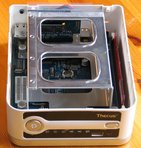Debian on the Thecus N2100

The Thecus N2100 is a Network Attached Storage (NAS) device based on Intel's IOP 80219 CPU and it can be used to run Debian. It offers the following features:
- Intel IOP 80219 CPU running at 600 MHz
- 2 SATA slots
- 1 DDR400 slot, populated with 128 MB RAM
- 3 USB 2.0 ports
- 2 GBit Ethernet
- 1 mini-PCI slot
These specs are similar to comparable NAS devices but one special feature of the N2100 is that it features a normal, expandable DDR400 RAM slot. In theory, up to 1 GB are supported using 64-bit DDR RAM, but RedBoot needs major modifications to support more than 512 MB.
While this device was produced by Thecus and sold as the Thecus YES Box N2100, it was also available from a number of other companies. The only difference is that some of those vendors include 256 MB rather than 128 MB RAM. So far, the following devices based on the Thecus N2100 are known:
- Allnet ALL6500
- ARP Datacon NAS-2100
- Evesham SilverSTOR M-Box
Support status
While the Thecus N2100 was supported up to Debian 7 (wheezy), it is no longer supported in Debian 8 (jessie) or later releases.
Information
- An installation guide for Debian on the Thecus N2100.
- A list of known issues and bugs with Debian on the Thecus N2100.
- A status page showing which components of the Thecus N2100 are currently supported.
- An internals page listing the specs of the Thecus N2100.
- An image gallery with various pictures showing the internals of the Thecus N2100.
- Recovery mechanism using telnet to RedBoot.
- Some de-installation instructions in case you want to go back to the original Thecus firmware.
External resources
- David Karlström describes how to connect a serial console.
- OpenBSD's armish port supports the Thecus N2100.
Acknowledgements
Thecus for providing an N2100 to Lennert Buytenhek and me, for answering some questions in great detail and for generally supporting this effort. Lennert Buytenhek integrated support for the Thecus N2100 into the mainline kernel and significantly improved generic IOP support. David Karlström and Riku Voipio reverse-engineered various aspects of this machine, and Riku also wrote a driver for the fan and LEDs.